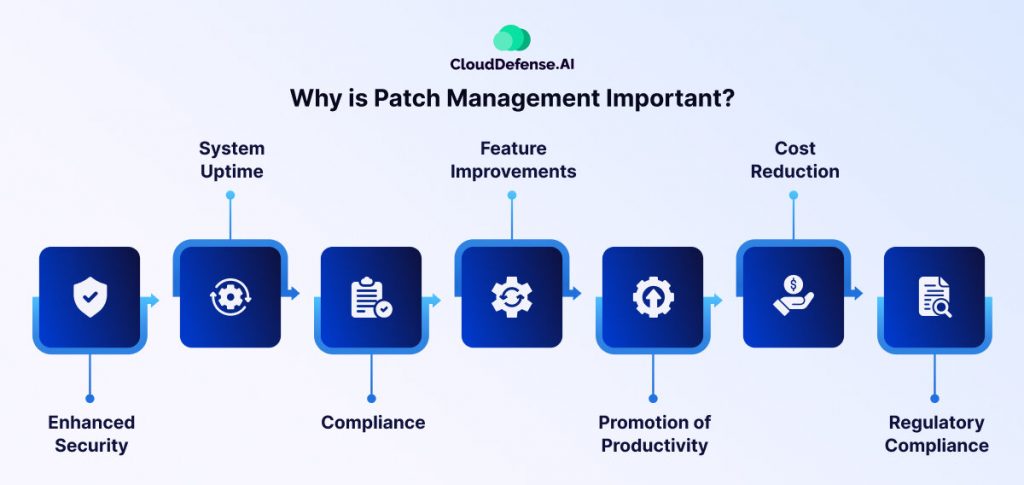Protecting your business from known exploits and unauthorized access has become more important than ever. With attacks growing in sophistication and frequency, proactive strategies are essential to protecting digital assets.
Patch management stands as one of the first defenses against vulnerabilities, ensuring software and systems remain protected before potential threats become exploitable.
In our blog, we will explore the fundamentals of patch management, exploring its types, lifecycle, and benefits. We will also highlight best practices to optimize your patch management strategy.
Stay tuned as we uncover the importance of patch management in strengthening your organization’s cybersecurity posture and reducing risks effectively.
What is Patch Management?
Patch management is the systematic process of applying updates, including software, drivers, and firmware, provided by vendors to address vulnerabilities and enhance the performance of systems and devices.
It involves the distribution and application of patches to correct errors or bugs in software, ensuring optimal operating performance and protecting against security threats. Effective patch management is essential for maintaining the integrity and security of systems and reducing the risk of breaches, data leaks, and productivity losses.
Why is Patch Management Important?

Patch management is essential to companies for several reasons, some of which are as follows:
- Enhanced Security: Patch management addresses vulnerabilities in software and applications, reducing the organization’s susceptibility to cyberattacks.
- System Uptime: By keeping software up-to-date, patch management minimizes disruptions and downtime, ensuring continuous system availability and functionality.
- Compliance: Regulatory bodies often mandate maintaining a certain level of security. Effective patch management helps organizations adhere to these standards, ensuring compliance with laws and regulations.
- Feature Improvements: Beyond security fixes, patch management includes feature/functionality updates, ensuring systems benefit from the latest enhancements and capabilities.
- Promotion of Productivity: Well-managed software with up-to-date patches works more efficiently, boosting employee productivity rather than hindering it, contrary to common misconceptions.
- Cost Reduction: Patch management lowers the cost of device lifecycle management and repair by enabling remote management tools, reducing the need for expensive hardware shipments or service calls.
- Regulatory Compliance: Patch management aids in meeting laws, regulations, and industry standards such as HIPAA and GDPR, ensuring the protection of sensitive data and regulatory compliance.
Patch Management vs. Vulnerability Management
Patch management and vulnerability management are both essential for keeping a company’s IT systems safe and running smoothly. Although people sometimes mix them up, they each have their own jobs and steps to follow.
| Focus | Core Functions | Similarities | Differences | |
| Patch Management | Addressing software vulnerabilities through patch deployment | Build IT inventory, prioritize patches, create patching policies, monitor & test patching systems, deploy patches, verify patch deployment, create patch reports & documentation | Categorization, monitoring, verification | Patching policies, analyzing vulnerabilities |
| Vulnerability Management | Identifying, assessing, and prioritizing vulnerabilities across IT infrastructure | Find and identify vulnerabilities, analyze vulnerabilities, categorize vulnerabilities, monitor vulnerabilities, remediate vulnerabilities, verify remediation | Categorization, monitoring, verification | Patching policies, analyzing vulnerabilities |
Benefits of Patch Management

Patch management comes with its fair share of benefits that you can utilize in your company. Here are a few advantages outlined below.
Better Visibility of Attack Surface
An efficient patch management program enables organizations to identify vulnerabilities across their enterprise’s systems.
By continuously monitoring for available patches and systematically deploying them, companies can pinpoint areas of exposure within their network, reducing the likelihood of successful cyber attacks.
Accurate Inventory of Assets
Understanding and maintaining an inventory of all assets is crucial for effective cybersecurity. Patch management involves the upkeep of a real-time inventory of assets and systems, providing organizations with a comprehensive view of what needs protection.
This ensures that no critical asset is left vulnerable due to oversight.
Enhanced Security
Regularly patching vulnerabilities helps organizations mitigate risks within their network environment, leading to a more secure infrastructure.
By addressing vulnerabilities promptly, companies can reduce the likelihood of cyber attacks and security breaches, safeguarding sensitive data and preserving business continuity.
Increased Remediation Efficiency
Not all vulnerabilities pose the same level of risk to an organization’s critical assets. An effective patch management program prioritizes patches based on their severity and relevance, allowing teams to focus on addressing high-risk vulnerabilities efficiently.
This targeted approach minimizes the time and resources spent on patching non-critical issues.
Compliance
Compliance with security standards is essential for avoiding fines and penalties from regulatory agencies. Patch management plays a vital role in maintaining compliance by ensuring that systems are up-to-date with the latest security patches.
This helps organizations adhere to regulations such as HIPAA and GDPR, protecting both customer and company data from unauthorized access and exploitation.
Device and Data Security
Patching vulnerabilities with the latest software updates strengthens device and data security, reducing the risk of data breaches.
By addressing security weaknesses promptly, organizations can prevent sensitive information from falling into the wrong hands and uphold the confidentiality and integrity of their data.
Improved User Experience
Patch management contributes to a smoother user experience by ensuring that devices run efficiently without interruptions.
By addressing performance issues and bugs promptly, organizations can enhance productivity and user satisfaction, allowing employees to focus on their tasks without disruptions caused by software vulnerabilities.
How It Works: The Patch Management Lifecycle
The patch management lifecycle is a systematic process designed to ensure that software vulnerabilities are promptly identified, prioritized, addressed, and verified to maintain a secure IT environment. It involves several steps, each with its specific tasks and objectives.
Step 1: Identification
The lifecycle begins with the identification of vulnerabilities and available patches. This involves conducting a thorough network inventory to identify all IT assets and monitoring vendor sites for known vulnerabilities and updates.
Step 2: Prioritization
Next, vulnerabilities are prioritized based on factors such as severity, potential impact, and criticality of affected systems. High-risk vulnerabilities are given top priority to minimize the risk of cyberattacks.
Step 3: Policies
Patch management policies are established to determine which patches need to be applied, when, and under what conditions. These policies provide guidelines for patch deployment and help ensure consistency and efficiency.
Step 4: Monitoring
Continuous monitoring is crucial to stay informed about new patches and vulnerabilities from vendors. Organizations set up systems to receive notifications about upcoming patches and vulnerability updates.
Step 5: Testing
Before deployment, patches are tested in a non-production environment to detect any conflicts or issues. This ensures that patches operate as intended and do not cause disruptions in the IT environment.
Step 6: Modifications
Any necessary documentation or adjustments are made before deploying patches to ensure all stakeholders are informed and prepared for the changes.
Step 7: Deployment
Patches are deployed according to the established patch management policies. Automated deployment tools streamline the process and reduce the risk of human error.
Step 8: Audit
Pending or failed patches are closely monitored for incompatibility or performance issues. End-users are advised of any issues and upcoming solutions if necessary.
Step 9: Report
Patch compliance reports are generated regularly to provide insight into the organization’s IT infrastructure and patching effectiveness. This helps stakeholders make informed decisions and track progress over time.
Step 10: Repeat
The patch management lifecycle is a continuous process that requires regular review, updating, and repetition of the previous stages. This ensures that information remains up-to-date and accurate, allowing organizations to refine and optimize their patch management processes over time.
Patch Management Best Practices
Effective patch management is crucial for maintaining the security and functionality of your organization’s IT infrastructure. To optimize your patching process, implementing best practices is essential.
Here are seven key patch management best practices to enhance your cybersecurity posture and streamline your operations:
Automate Patch Deployment
Utilize automated patch deployment tools to efficiently scan for missing patches and install them on endpoints, reducing response time and minimizing manual effort.
Prioritize Critical Updates
Adopt a critical-updates-first approach to prioritize and promptly address critical vulnerabilities, ensuring the most urgent patches are applied without delay.
Schedule Regular Deployments
Implement scheduled auto-deployments at least twice a week to ensure endpoints receive timely patch updates, allowing for proper testing and approval while maintaining security.
Allow User Intervention
Maintain user productivity by offering flexible deployment policies that allow users to postpone updates if necessary, ensuring business-critical tasks remain unaffected.
Test Patches in a Controlled Environment
Before deploying patches to endpoints, thoroughly evaluate them in a test environment to identify and mitigate potential conflicts or issues, minimizing disruptions to production systems.
Maintain Comprehensive Documentation
Keep detailed records of deployed patches and communicate system changes to stakeholders, facilitating accountability and providing clarity on patching activities.
Stay Informed with Best Practices
Continuously educate yourself on evolving patch management best practices to adapt and refine your patching strategy, ensuring your organization remains resilient against emerging threats.
Conclusion
Patch management is a must-have feature to strengthen cybersecurity defenses, regardless of an organization’s size or industry. By promptly addressing vulnerabilities and keeping software up-to-date, businesses can effectively manage risks and protect their assets.
Moreover, patch management offers greater control and flexibility to IT departments, empowering them to maintain a secure and resilient infrastructure. As cyber threats continue to evolve, investing in strong patch management practices remains essential for ensuring the smooth operation and protection of businesses today.







